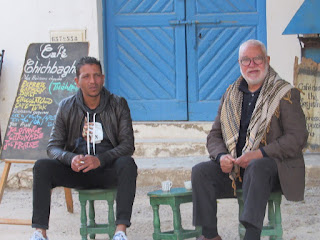This morning we got an early start at 5:30. That meant I got up at 3:55 to shower and have breakfast. We were supposed to fly to Djerba Island, but our flight was cancelled. So, we took our bus on a long ride to the southeastern part of the country to the island. The advantage to this change of plans was that we saw the gradual change in the landscape from green trees to palm trees and sand. Of course, the ever-present olive trees were still visible over acres and acres of land. We also stopped at the Mareth Line Military Museum where German Field Marshal Rommel was stopped by French and British troops. Click here to see my blog on the museum.
In order to get to the island, we took a ferry boat. We were extremely lucky that the line to board the boat was not long, and we didn't have to wait. This boat and another one goes back and forth with people, vehicles, and cargo. Here the boat we will soon board is unloading.

After we were on the boat, we had a good look at the scenic shore. We took photos of each other and the other people, cars, and our faithful bus.



As we crossed the channel, we could see the next boat to land on the mainland. What a beautiful day in a glorious setting!
We crossed a little strip of the beautiful blue Mediterranean Sea to the island that was reputedly the "land of the lotus eaters" where a peaceful people lived and did nothing but eat the lotus flowers. According to Homer's Odyssey, Ulysses almost lost his men when the beautiful maidens of the island fed them the lotus flower. Anyone who eats this sweet plant becomes forgetful of their purpose and tempted into forgetfulness and apathy. Ulysses' men almost lost their desire to return home.
Djerba was first settled by the Greeks and later truly developed by the Phoenicians of Tyre and Sidon in the 12th century BC. During this period, trade flourished thanks to the pottery industry and the manufacture of purple dye, which historians say was comparable to, if not superior to, the purple of Tyre. The Phoenicians also introduced the planting of olive trees and olive pressing. Tunisia was then and still is one of the capitals of olive oil production in the Mediterranean along with Italy and Spain.
The Romans supplanted the Phoenicians and the island witnessed even greater prosperity and urbanization. However, in the fifth century as the Roman Empire fell, the Vandals, a Germanic tribe who had emigrated to the Maghreb in 429 CE, conquered the island under the leadership of its king, Gaiseric.
Today, it's a favorite vacation spot for Libyans and Tunisians and one of the best-known and longest-lasting North African Jewish communities. Many Jews make an annual pilgrimage to the El Ghriba Synagogue, which we visited (see below).
After we landed on the island, we traveled on the main road for about 20 minutes before we reached the restaurant where we had lunch. It was near this Catholic church where today the French, Italians, and Spanish go after Mass.
The church was established in 1848 by the Maltese and Italian communities on the island. It is considered as one of the last churches still functioning. The Mass and prayers are said in different languages.

This man was at another table. He looked very Italian to me in features and movements. He leaned in his chair as he ate and seemed to enjoy every bite. I really wanted to take a photo of him but didn't want to be rude and obvious. I did manage to build up the courage to sneak a shot or two of him.
After lunch we walked around the souk and marveled at all the wares. I bought another magnet for my collection.


This man is roasting and then coating almonds with honey or sugar like my grandmother used to do.

After a look around the souk, I joined a small group of fellow travelers for coffee and had a beautiful cappuccino at a famous coffee shop on the island.

The group re-assembled and our bus took us to the Jewish synagogue. It was a marvel of intense color and decoration. The men and women are separated during services and sit on benches that face each other.







Anas, our guide, took us through another neighborhood full of murals that were painted by people from all over the world.







The neighborhood also had many shops. We passed them and many local people of Djerba Island.

The doors of Djerba Island are equally fascinating. Here are some examples. The colors and decorations of Tunisia are part of the reason I find it so charming.






Resources
Lotus Eaters -- https://en.wikipedia.org/wiki/Lotus-eaters


















































No comments:
Post a Comment